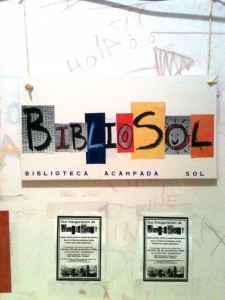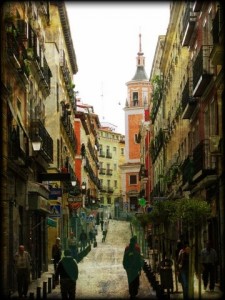Lavapiés and the anarchist roots of 15-M
How much does Spain’s 15-M movement owe to past political struggles? The protests that broke out on May 15, 2011 reveal an interesting convergence of the old and the new. On the one hand, the encampment at the Puerta del Sol in Madrid (Acampada Sol) was a 21st-century revolution driven by social media like Twitter and Facebook. On the other, banners proclaiming “no nos representan” [they don’t represent us] y “no les votes” [don’t vote for them] flew side by side with three-colored Republican flags, against the backdrop of the Real Casa de Correos from which the Second Republic was proclaimed on April 14, 1931.
But the legacy of the 1930s is not just visual. Harking back to Spain’s libertarian tradition, the protests have a strong anarcho-syndicalist streak. This is clear not just in the commitment to the philosophy of self-management or autogestión as a means to break down traditional hierarchies, or in the deep suspicion of the State and its traditional power players such as formal trade unions and political parties. More crucially, the 15-M movement was and is driven by leaderless, horizontally-organized general assemblies and collective decision making.
Although these features are merely one thread of the 15M movement, they uncover a rich cultural history of protest and activism in Madrid, with a special role for the iconic working-class neighborhood of Lavapiés, which has been a source of political resistance for nearly two centuries.
Each Sunday in the Plaza Tirso de Molina, temporary tables and booths offer a vast array of anarchist and Republican merchandise for sale to the throngs of visitors rising from the metro station to begin the weekend ritual of Madrid’s Sunday flea market, the Rastro. As it happens, the Confederación Nacional del Trabajo (CNT) has its principal office in a building facing the Plaza, marked by a large red and black banner. The plaza is also a gateway into the narrow, sloping streets of Lavapiés—a barrio bajo that is not just physically lower than the rest of the city, but also has long been on the social and economic margins of the capital. In the fifteenth and sixteenth centuries it was the Jewish quarter (judería); later it became a collection point for recently arrived provincial immigrants who came to Madrid in pursuit of work.
Today, Lavapiés continues to boast one the most multi-cultural populations in Madrid, combining curry houses, halal butchers, Chinese wholesalers, and Senegalese restaurants with a robust alternative arts and theater culture. Although during the last fifteen years Lavapiés has become a fashionable neighborhood for neo-bohemian professionals, the association with marginal populations lives on in a strong activist tradition.
Lavapiés’ traditionally working-class character helps explain much of its history of social upheaval. It was here that, in 1781, King Carlos III built his Real Fábrica de Aguardientes y Naipes [Royal Factory of Liquor and Playing Cards], which a quarter of a century later was converted into the Real Fábrica de Tabaco [Royal Tobacco Factory], or Tabacalera. As Madrid became industrialized, the factory was slowly modernized as well. Its largely female work force of cigarreras, or cigar rollers, lived in the surrounding neighborhoods, which became a center of working-class culture and activism. A strike in 1830 paralyzed tobacco production in the city; in 1885 another strike protested the mechanization of the cigarette rolling process, under the slogan “¡arriba niñas!” [rise up girls!]. Little of this activist streak made it into the sexy, idealized image of the cigarrera in Georges Bizet’s 1875 comic opera Carmen and Spanish musical theater. The archetype of the southern, sensual cigarrera from Lavapiés would become a mainstay of commercial theater in the early twentieth century. The neighborhood, meanwhile, came to stand for the genuine, popular Madrid.
In the 1970s, neighborhood associations adopted this literary stereotype to channel their grassroots political activism, protesting the longtime neglect by the city and the national government. The main neighborhood association was called La Corrala—a reference not only to the area’s distinctive communal housing from the nineteenth century, but also to the need for architectural, historical, and cultural preservation. La Corrala drew regular, 600-member general assemblies in 1977 that swelled to nearly 1,600 two years later, taking on issues such as water supply, urban decay, or the displacement of residents by increasing gentrification. Its activities included cultural festivals that reintegrated the tradition of street parties or verbenas into the life of the neighborhood, with residents wearing costumes associated with the cigarreras, chulapas, and chulaponas of the early twentieth century. For a fractured and fading Francoist regime, these protests were a difficult challenge: the citizens of Lavapiés affirmed their right to the city as well as a sense of shared cultural heritage. More importantly, they reclaimed public space after decades of silence imposed by the oppressive Francoist bureaucracy.
The tradition of working-class protest in Lavapiés is only one of the legacies to which “15-M” owes a debt. Another is the okupa movement. Okupas or squatters emerged in the late 1980s, combining punk do-it-yourself culture with ideological influences from squatter movements in Holland, Germany, Italy, and England. They shared an anarcho-syndicalist dedication to the anti-state principles of autonomy and self-management. In contrast to squatters of necessity, who occupy in buildings primarily for lack of housing, the okupas (usually spelled with a countercultural K) would typically claim abandoned buildings in a neighborhood left derelict by real estate speculation, turning them into self-managed social centers providing space for community groups, artists, and others to meet, interact, organize, and manage the affairs of the local neighborhood. Their civil disobedience was grounded in two principles: the occupation of space for the public good and the promotion of a community based on principles of horizontality and self-management. These principles are fundamental to the 15-M movement as well. In fact, okupa veterans offered 15-M important logistical experience in the first days of the encampments. (The encampment in the Puerta del Sol, in turn, helped provide the “ground game” for the success in the fall of 2011 of Occupy Wall Street, which sprung from the culture-jamming magazine Adbusters and the radical activism of its founding editor Kalle Lasn.)
Here, once again, Lavapiés looms large. In part because of the neighborhood’s cheap housing and counter-cultural vibe, some of Madrid’s most important centros sociales okupados autogestionados (CSOA), or self-managed social squatter centers, have been located in Lavapiés. These include La Minuesa, which started when workers at a printing factory locked themselves in the building to protest layoffs. Soon after, activists from the neighborhood moved into the living spaces at the site while the neighborhood association began to hold assemblies. La Minuesa sparked similar squatted social centers in other parts of Madrid under the same name. It later saw an extremely violent eviction by city police—an event that strengthened activist resolve and became an important historical reference point for the history of okupación in Madrid.

Entrance to the "BiblioSol" or encampment library from the Puerta del Sol in the CSOA Casablanca. Photo Matt Feinberg.
This pattern would be replicated just few years later when activists took over the large empty agriculture research facility on Embajadores Street to establish a CSOA that they named El Laboratorio, inspired by the building’s original use as a lab facility. Between 1997 and 2004 the Laboratorio would be evicted three times, only to reemerge at other locations in the neighborhood. By the time the Laboratorio 03 was established in early 2002, at 103 Amparo Street, the okupas had become an important part of the neighborhood’s fight against the ongoing gentrification and real estate speculation in Lavapiés. For a time, it provided meeting space and organizational leadership for the “Red de Lavapiés,” a network of neighborhood associations, women’s groups, and various immigrant organizations that sought to pool their collective energy into a community effort to protect the neighborhood’s uniquely diverse culture. In 2003, these efforts converged with the broader movements in Spain and Madrid to resist the Spanish participation in the invasion of Iraq and to protest the environmental disaster of the Prestige oil tanker off the coast of Galicia. The Laboratorio also helped consolidate the Internet as a medium for protest against the State and the interests of global capital. In 2003, it served as the site for one of the first meetings in Spain that brought together computer hackers to share strategies, techniques, and philosophies. Through the Laboratorio, in other words, Lavapiés not only became an important hub for protesting broader national causes, but also one of the incubators of the tactics of the 15M movement and its North American “cousin,” Occupy Wall Street.
Meanwhile, activists in Lavapiés were taking to the streets to reclaim another important space in the neighborhood: the recently closed tobacco factory or Tabacalera, which had been dormant since 2002. Significantly, these efforts to reclaim this large unused building in a neighborhood devoid of community spaces coincided with an effort to connect with the combative spirit of the cigarreras and channel the building’s anarcho-syndicalist past. Those interested in appropriating the building for the community held a march they called the cigarrera parade, or Desfile de Cigarreras, announcing: ‘Las brigadas cigarreras salen de nuevo’ [the cigarrera brigades return]. The call to protest offered potential participants directions for how to dress like a cigarrera, suggesting any long skirt and shawl capped off with a red flower and cigar.
After several years of petitioning the Ministry of Culture for use of the building, the neighborhood collective won out when the Ministry’s plans for a National Museum of Visual Arts were put on hold in the midst of the devastating economic crisis that began in 2008. In 2011, a large portion of the building was ceded to the activist collective. Since then, the building has been converted into a quasi-official self-managed social center. As such, it joined with another nearby social center, CSOA Casablanca on the Calle Santa Isabel to provide a wide-ranging degree of logistical and material support to the Acampada Sol. Old materials like shelves, chairs, and desks from the Tabacalera’s factory days were used to construct the encampment. Once the encampment had been evicted, both sites—along with the CSOA Patio Maravillas in Malasaña—became spaces for the assemblies that continued to be held. (On the occasion of the global day of protests on October 15 of 2011, the Spanish daily El País described the Tabacalera as one of the movement’s neurological centers.) Given their proximity to the Puerta del Sol, both sites also became refuges for the abundance of materials produced during the three and half weeks that the encampment lasted. The encampment’s library, aka BiblioSol as well as its archives found a home in the squatted social center Casablanca—which was evicted in November 2012. Following the eviction, the police refused to return the materials and, supposedly, disposed of them. If true, this would be a tremendous cultural loss.
The spirit of Lavapiés is deeply embedded in the tactics and the ideological legacy of the Acampada Sol and 15-M Movement. Although by now the magic of the social media has made the movement at once placeless and ubiquitous, some of the historical roots and contemporary threads of its activist energy and cultural heritage can be found in the multi-faceted barrio bajo and its activist legacies ranging from combative cigarreras and activist neighborhood associations to okupas and the spirit of autogestión.

















[…] Lavapiés and the Anarchist Roots of 15M. Share this:TwitterFacebookEmailLike this:LikeBe the first to like this. This entry was posted in Uncategorized and tagged #15M, geography and literature, Lavapiés, Occupy by mfeinb. Bookmark the permalink. […]
[…] Blanca. A huge, well established squat/social centre that was a coordination point for much of the 15-M protests until police cracked down and unceremoniously concreted up all the windows and […]